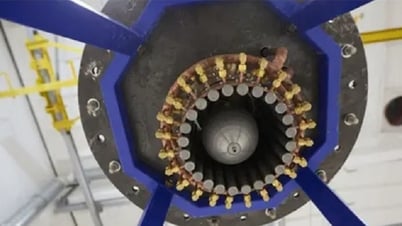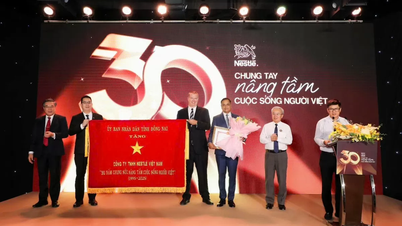A team of scientists and engineers are developing a new generation of plasma stealth equipment that could help almost any military aircraft disappear from radar screens.

Plasma stealth technology could give fighter jets a huge advantage. Photo: Weibo
Unlike previous versions that created a plasma cloud that covered the aircraft, the new technology can be adjusted to cover areas that are easily detected by radar on military aircraft, such as the radome, cockpit, or other locations. This closed electron beam plasma stealth device focuses on protecting important areas instead of the entire aircraft, Interesting Engineering reported on February 19. It has many advantages such as a simple structure, a wide voltage adjustment range, and a high plasma density, Tan Chang, a scientist involved in the project, described in the Chinese magazine Radio Science.
The technical solution could soon be used on a variety of military aircraft, according to Tan and colleagues at the Plasma Technology Center of the Xi'an Aerospace Propulsion Institute of the China Aerospace Science and Technology Corporation.
Plasma consists of charged particles that interact with electromagnetic waves in a unique way. When electromagnetic waves, such as those emitted by radar, interact with plasma, they cause the particles to move rapidly and collide, dispersing the wave energy. The interaction converts the energy of the electromagnetic wave into the mechanical and thermal energy of the charged particles, thereby reducing the intensity of the electromagnetic wave and weakening the radar signal transmitted back. Even conventional fighter aircraft that are not designed for stealth can significantly reduce their radar detection ability with plasma stealth devices, providing an advantage in air combat.
Plasma can change the frequency of reflected signals, giving enemy radars inaccurate data on a plane’s location and speed. It can also act as an invisible “shield” against high-power microwave weapons. A growing number of Chinese military researchers believe the technology will play a key role in the future.
Tan's team tested two types of plasma cloaking devices. One covered the radar-sensitive areas of the aircraft with radioactive isotopes, emitting high-energy rays that ionized the surrounding air. The result was a plasma layer thick and dense enough to cover the surface and scatter radar signals. The other used high voltage to ignite and ionize the air outside the aircraft, creating a plasma field. Both methods of achieving stealth through low-temperature plasma have undergone flight testing and were successful, according to the researchers.
Current plasma stealth technology has some limitations. Plasma is difficult to shape precisely in open environments, and maintaining a consistently high density is also a challenge. Gaps in the plasma can allow electromagnetic waves to reflect back, revealing the aircraft’s location.
Tan's team developed a device that uses an electron beam to create a large, enclosed plasma. Compared to other techniques such as enclosed radio frequency plasma devices, their method separates the plasma from its source, providing greater design flexibility to accommodate different aircraft configurations. According to them, the plasma produced by an electron beam is easier to tune in terms of physical properties, has higher energy efficiency, reduces the need for electrical power from the aircraft, and is lighter, making it ideal for practical applications. Ground-based prototype testing has demonstrated the feasibility of the design.
An Khang (According to Interesting Engineering )
Source link


![[Photo] General Secretary To Lam begins official visit to Russia and attends the 80th Anniversary of Victory over Fascism](https://vphoto.vietnam.vn/thumb/1200x675/vietnam/resource/IMAGE/2025/5/8/5d2566d7f67d4a1e9b88bc677831ec9d)


![[Photo] National Assembly Chairman Tran Thanh Man chairs the meeting of the Subcommittee on Documents of the First National Assembly Party Congress](https://vphoto.vietnam.vn/thumb/1200x675/vietnam/resource/IMAGE/2025/5/8/72b19a73d94a4affab411fd8c87f4f8d)

![[Photo] Prime Minister Pham Minh Chinh meets with the Policy Advisory Council on Private Economic Development](https://vphoto.vietnam.vn/thumb/1200x675/vietnam/resource/IMAGE/2025/5/8/387da60b85cc489ab2aed8442fc3b14a)











![[Video] Institute of Social Science Information celebrates 50th anniversary](https://vphoto.vietnam.vn/thumb/402x226/vietnam/resource/IMAGE/2025/5/8/541d6946f8a14ed3824d7a3edafc652c)














![[Photo] President Luong Cuong presents the decision to appoint Deputy Head of the Office of the President](https://vphoto.vietnam.vn/thumb/1200x675/vietnam/resource/IMAGE/2025/5/8/501f8ee192f3476ab9f7579c57b423ad)



































































Comment (0)